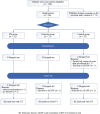Pulmonary Daoyin as a traditional Chinese medicine rehabilitation programme for patients with IPF: A randomized controlled trial
- PMID: 33164264
- PMCID: PMC8048896
- DOI: 10.1111/resp.13972
Pulmonary Daoyin as a traditional Chinese medicine rehabilitation programme for patients with IPF: A randomized controlled trial
Abstract
Background and objective: IPF is a chronic progressive lung disease in which PR provides benefit for patients. PD, a TCM PR programme, has known effectiveness in COPD, but its utility in IPF is unknown. We investigated its effectiveness and safety in patients with IPF.
Methods: A 6-month randomized controlled trial (RCT) was conducted in three Chinese clinics. Ninety-six participants diagnosed with IPF were randomly assigned to one of the three groups: the PD group received a PD programme two times a day, 5 days/week for 2 months, and the exercise group exercised via a stationary cycle ergometer, 30 min/day, 5 days/week for 2 months. Volunteers in the control group were advised to maintain their usual activities. Primary outcomes were changes from baseline in the 6MWD and HRQoL score on the SGRQ-I at 1 and 2 months (at the end of the intervention) and at 6 months (4 months after the intervention). Secondary outcomes measures included FVC, DLCO (% predicted) and the changes in mMRC.
Results: The 6MWD was increased in the PD group compared to exercise and control groups. 6MWD increased by 60.44 m in the PD group, 32.16 m in the exercise group and 12.42 m in controls after the 2 months of rehabilitation programme. The between-group differences in the change from baseline were 28.78 m (95% CI: 0.54 to 56.01; P = 0.044) and 48.02 m (95% CI: 23.04 to 73.00; P < 0.001) at 2 months, and 25.61 m (95% CI: -0.67 to 51.89; P = 0.058) and 50.93 m (95% CI: 25.47 to 76.40; P < 0.001) at 6 months, respectively, including a difference exceeding the MCID. There was no significant change in the SGRQ-I score, the mMRC dyspnoea score, FVC and DLCO (% predicted) in either the PD or exercise groups.
Conclusion: Two months after the intervention, a clinically meaningful difference in 6MWD was observed favouring the PD programme. The PD programme is safe and effective as a rehabilitation intervention designed to increase exercise tolerance and is an appropriate substitute for PR.
Keywords: 6-min walking distance; Daoyin; idiopathic pulmonary fibrosis; pulmonary rehabilitation; traditional Chinese medicine.
© 2020 The Authors. Respirology published by John Wiley & Sons Australia, Ltd on behalf of Asian Pacific Society of Respirology.
Figures


 , PD;
, PD;  , exercise;
, exercise;  , control. (B, D)
, control. (B, D)  , T1 − T0;
, T1 − T0;  , T2 − T0;
, T2 − T0;  , T6 − T0. (F, H)
, T6 − T0. (F, H)  , T2 − T0. 6MWD, 6‐min walking distance; DLCO, diffusing capacity of the lung for carbon monoxide; FVC, forced vital capacity; mMRC, modified British Medical Research Council; PD, pulmonary Daoyin; T1 − T0, changes at the first month study endpoint from baseline; T2 − T0, changes at the end of the rehabilitation study endpoint from baseline. T6 − T0, changes at the end of the follow‐up study endpoint from baseline.
, T2 − T0. 6MWD, 6‐min walking distance; DLCO, diffusing capacity of the lung for carbon monoxide; FVC, forced vital capacity; mMRC, modified British Medical Research Council; PD, pulmonary Daoyin; T1 − T0, changes at the first month study endpoint from baseline; T2 − T0, changes at the end of the rehabilitation study endpoint from baseline. T6 − T0, changes at the end of the follow‐up study endpoint from baseline.
 , PD;
, PD;  , exercise;
, exercise;  , control. PD, pulmonary Daoyin; SGRQ‐I, St George's Respiratory Questionnaire for IPF.
, control. PD, pulmonary Daoyin; SGRQ‐I, St George's Respiratory Questionnaire for IPF.References
-
- Naccache JM, Montil M, Cadranel J, Cachanado M, Cottin V, Crestani B, Valeyre D, Wallaert B, Simon T, Nunes H. Study protocol: exploring the efficacy of cyclophosphamide added to corticosteroids for treating acute exacerbation of idiopathic pulmonary fibrosis; a randomized double‐blind, placebo‐controlled, multi‐center phase III trial (EXAFIP). BMC Pulm. Med. 2019; 19: 75. - PMC - PubMed
-
- Lee HE, Myong JP, Kim HR, Rhee CK, Yoon HK, Koo JW. Incidence and prevalence of idiopathic interstitial pneumonia and idiopathic pulmonary fibrosis in Korea. Int. J. Tuberc. Lung Dis. 2016; 20: 978–84. - PubMed
-
- Natsuizaka M, Chiba H, Kuronuma K, Otsuka M, Kudo K, Mori M, Bando M, Sugiyama Y, Takahashi H. Epidemiologic survey of Japanese patients with idiopathic pulmonary fibrosis and investigation of ethnic differences. Am. J. Respir. Crit. Care Med. 2014; 190: 773–9. - PubMed
Publication types
MeSH terms
LinkOut - more resources
Full Text Sources
Medical
Research Materials

